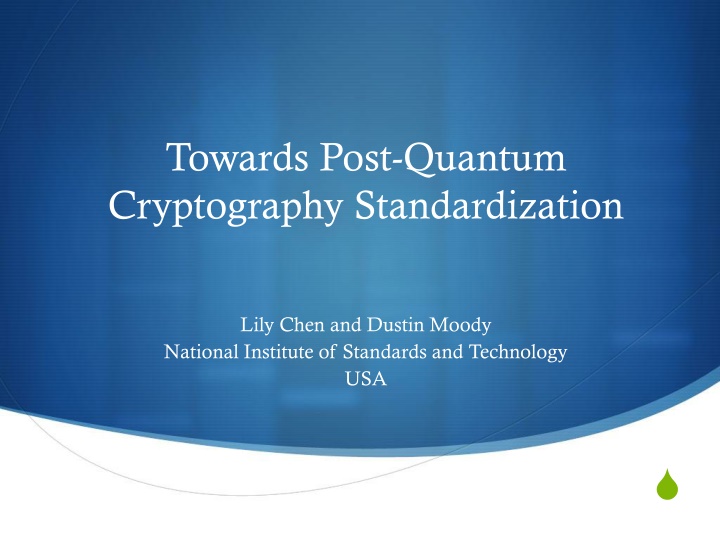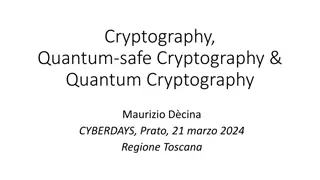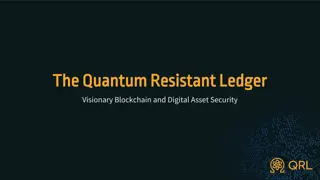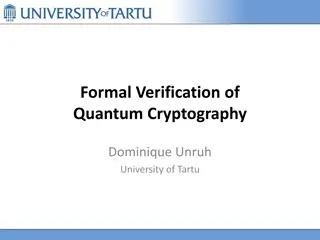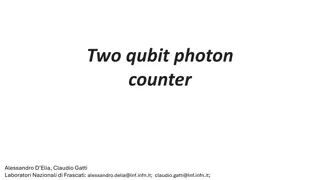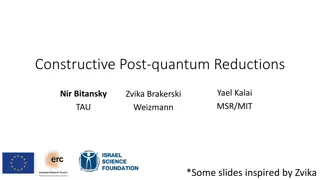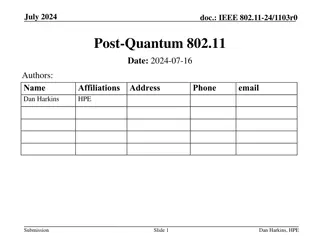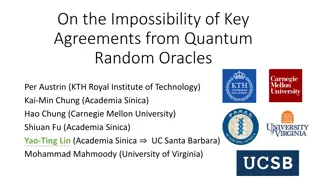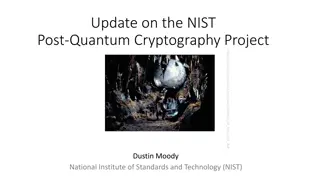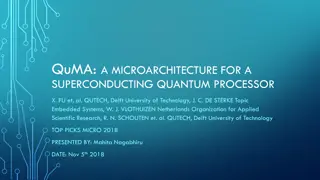Challenges in Post-Quantum Cryptography Standards
Scope of NIST's effort towards post-quantum cryptography standardization, including the complexities, requirements for proposals, and security notions for encryption, key establishment, and signatures.
Download Presentation

Please find below an Image/Link to download the presentation.
The content on the website is provided AS IS for your information and personal use only. It may not be sold, licensed, or shared on other websites without obtaining consent from the author.If you encounter any issues during the download, it is possible that the publisher has removed the file from their server.
You are allowed to download the files provided on this website for personal or commercial use, subject to the condition that they are used lawfully. All files are the property of their respective owners.
The content on the website is provided AS IS for your information and personal use only. It may not be sold, licensed, or shared on other websites without obtaining consent from the author.
E N D
Presentation Transcript
Towards Post-Quantum Cryptography Standardization Lily Chen and Dustin Moody National Institute of Standards and Technology USA
First mile - Towards PQC standardization After about four years preparation, NIST published a Federal Register Notice (FRN) August 2, 2016 Requesting comments on a proposed process to solicit, evaluate, and standardize one or more quantum-resistant public-key cryptographic algorithms Comment period closed September 16, 2016 What we observed in the first mile?
Overview of NIST call for proposals Requirements for Submission Packages Cover sheet, supporting document, media, IP statement Minimum Acceptability Requirements Scope Public key crypto algorithms on digital signature, encryption, key establishment Basic requirements for each function Evaluation Criteria Security definitions, targeted security strength (classical and quantum), costs, etc. Plans for the Evaluation Process
Complexities of PQCS Scope with three main cryptographic primitives Both classical attacks and quantum attacks Both theoretical and practical aspects Multiple factor tradeoffs (security, key sizes, signature sizes, ciphertext expansion, etc.) Migrations, and Anything which we have never handled in the previous standards
Scope of NIST PQCS Encryption/key establishment Encryption scheme is used for key transport from one party to another, like RSA-OAEP or exchanging encrypted secret values between two parties to establish a shared secret value Key establishment scheme like Diffie-Hellman key exchange Signature Signature schemes for generating and verifying digital signatures
Security notions Signature Existentially unforgeable with respect to adaptive chosen message attack (EUF- CMA) Assume the attacker access to no more than 264decryptions for chosen ciphertexts Encryption Semantically secure with respect to adaptive chosen ciphertext attack (IND- CCA2) Assume the attacker access to no more than 264signatures for chosen messages These definitions specify security against attacks which use classical (rather than quantum) queries 264online queries are consider beyond realistic These definitions are used to judge whether an attack is relevant
Target classical and quantum security The following metrics are considered as the minimum security strength at different levels to enable transition from one security level to another For a given parameter set, the algorithm may provide different ratio as listed between classical security and quantum security For a given algorithm, with different parameter sets, it is expected to provide different security levels, if not all five, at least more than one level Classical Security 128 bits Quantum Security 64 bits Examples I AES128 (brute force key search) II 128 bits 80 bits SHA256/SHA3-256 (collision) III 192 bits 96 bits AES192 (brute force key search) IV 192 bits 128 bits SHA384/SHA3-384 (collision) V 256 bits 128 bits AES256 (brute force key search)
Quantum security The best quantum attack against most proposed postquantum schemes seems to either be the classical attack or something similar to Grover's algorithm Further studies are needed regarding the best way to measure quantum attacks Scaling up is a difficult engineering problem Too early to predict: anything like Moore's law for quantum devices? Need the empirical performance of quantum cryptanalytic attacks, e.g. running them on classical simulators or small quantum computers Additional factors to consider: Parallel attacks Limited (but easier to implement) models of computation E.g. classical computing, hybrid classical-quantum attacks, adiabatic computing etc.
Drop-in Replacement For a given primitive, in order to be used in an existing protocol, we need consider Parameter set Key generation Key length Ciphertext expansion/signature size Auxiliary functions (hash functions, key derivation functions, random number generations, etc.) For an existing protocol, in order to use a specific PQC primitive, we might need to consider whether a special feature can bring about security or performance issue, e.g. Public key reuse - for some new primitives public key reuse can bring about security problem which would not be suitable for public key cache in TLS Decryption failure some encryption algorithms, even occasionally, produce ciphertexts which cannot be properly decrypted
Transition and migration Transition and migration are important to assure the security will be maintained and services are not interrupted NIST guidance need to be updated when PQC standards are available NIST SP 800-57 Part 1 specifies classical security strength levels 128, 192, and 256 bits acceptable through 2030 or beyond 2031 Even foreseeing upcoming transition to quantum resistant cryptographic schemes, it is still required to move away from the weak algorithms/short key sizes as specified in 800-131A, i.e. Anything with classical security strength less than 112 bits should not be used any more
Some initial actions Hybrid mode has been proposed as a transition/migration to PQC cryptography Current FIPS 140 validation will only validate the approved component PQC standardization will focus on quantum resistant component Hybrid mode should not be considered as a long term quantum resistant solution for its implementation burden (a double edge sword) Stateful hash based signatures IETF has taken actions in specifying stateful hash based signatures NIST will coordinate with IETF and possibly other standard organizations NIST may consider stateful hash-based signatures as an early candidates for standardization, but just for specific applications like code signing
Summary Post-quantum cryptography standardization is going to be a long journey By the first mile, we have observed complexities and challenges NIST acknowledges all the feedbacks received on call for proposals NIST will continue to work with the community towards PQC standardization
